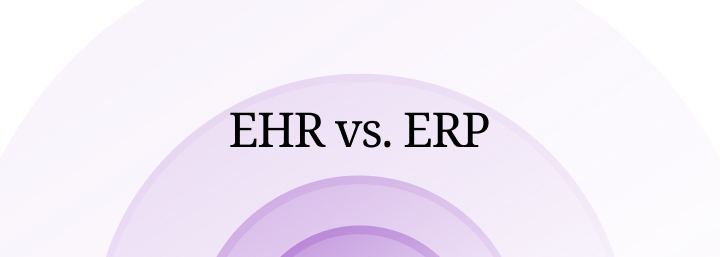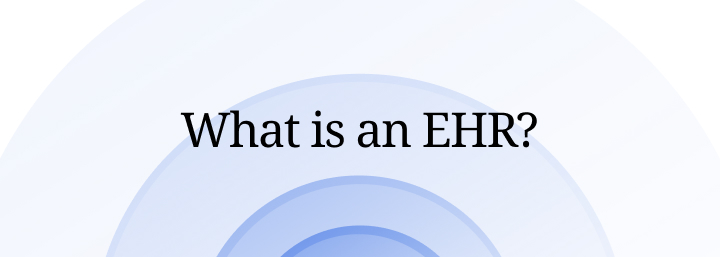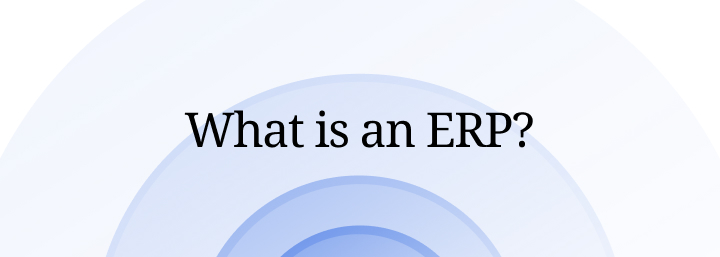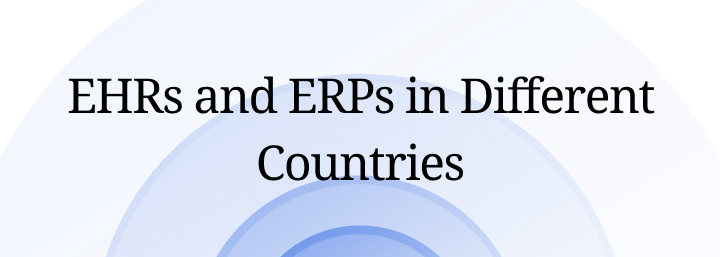Documentation and Administrative Tasks?
Healthcare is a complex and dynamic industry that requires efficient and effective management of various resources, processes, and information. To achieve this, healthcare organizations need to use various software systems that can help them streamline their operations, improve their quality of care, and reduce their costs.
Two of the most common software systems that healthcare organizations use are EHR and ERP. EHR stands for Electronic Health Record, and ERP stands for Enterprise Resource Planning. Both of these systems have different functions and purposes, but they also have some similarities and connections.
In this blog post, we will explore the difference between EHR and ERP, their pros and cons, and why they are important for healthcare organizations. We will also look at some examples of how EHRs and ERPs are used in different countries and how they can impact the healthcare industry.

Before we dive into the details of what EHR and ERP are, let’s first understand why it is important to know the difference between them. Knowing the difference between EHR and ERP can help healthcare professionals:
Choose the right software system for their specific needs and goals
Optimize the performance and functionality of their software system
Avoid confusion and errors when using or integrating different software systems
Enhance their communication and collaboration with other stakeholders
Comply with the regulations and standards of their industry
Stay updated with the latest trends and innovations in their field
By understanding the difference between EHR and ERP, healthcare professionals can make informed decisions that can benefit their organization, their patients, and themselves.

To gain a comprehensive understanding of the issue at hand, it is beneficial to examine and familiarize oneself with each of these two systems separately. In the following, we will delve into EHRs to acquire a thorough understanding.
An EHR is a digital version of a patient’s medical history, diagnosis, treatment, medications, allergies, immunizations, lab results, vital signs, and other health-related information. An EHR is created and maintained by authorized healthcare providers within a single organization or network. An EHR can be accessed and shared by different healthcare providers across different settings, such as hospitals, clinics, pharmacies, laboratories, etc.
The main purpose of an EHR is to improve the quality and continuity of care for patients by providing accurate, comprehensive, and up-to-date information about their health status and history. An EHR can also help healthcare providers improve their efficiency, productivity, safety, and satisfaction by reducing paperwork, duplication, errors, delays, and costs.
Some of the benefits of using an EHR include:
Enhanced patient outcomes: By providing access to the patient's complete medical history, current condition, allergies, and medications, EHRs enable healthcare providers to make informed decisions. Additionally, EHRs contribute to the prevention of medical errors like misdiagnosis, adverse drug reactions, and duplicate tests.
Improved patient engagement: Patients can conveniently access their health information online or via mobile devices, while securely communicating with healthcare providers through messaging or telehealth services. Additionally, patients actively participate in their care by providing feedback and expressing their preferences.
Increased coordination of care: EHRs can help healthcare providers collaborate with each other across different settings or specialties. An EHR can also facilitate the exchange of information with other entities such as insurance companies, public health agencies, research institutions, etc.
Reduced operational costs: By replacing paper records, manual processes, redundant tests, and unnecessary referrals, EHRs assist healthcare providers in saving time and money. Additionally, EHRs aid in optimizing workflow, resource utilization, and revenue cycle management.

At this stage, in order to broaden our understanding and obtain a clearer view, it is essential to develop a thorough understanding of ERPs. Now we want to know what ERPs are?
An ERP is a software system that integrates various business functions such as accounting, finance, human resources, inventory, supply chain, customer relationship management, etc. An ERP is used by organizations across different industries such as manufacturing, retail, education, etc. An ERP can be customized to suit the specific needs and goals of each organization or industry.
The main purpose of an ERP is to streamline the operations of an organization by providing a centralized database that stores and processes all the data related to its business functions. An ERP can also help an organization improve its efficiency, effectiveness, competitiveness, and profitability by automating processes, enhancing data quality, increasing visibility, and enabling analytics.
Some of the benefits of using an ERP include:
Improved operational performance: By eliminating waste, reducing errors, increasing speed, and ensuring compliance, an ERP enables organizations to optimize their business processes. Moreover, an ERP facilitates real-time data and report availability, empowering organizations to monitor and measure their performance effectively.
Enhanced customer satisfaction: By delivering accurate, timely, and personalized information and solutions, an ERP empowers organizations to enhance customer service. Furthermore, an ERP aids in customer retention and attraction by enabling improved product offerings, competitive pricing, and effective promotional strategies.
Increased collaboration and innovation: An ERP can help an organization foster a culture of collaboration and innovation by facilitating communication and knowledge sharing among its employees, partners, and suppliers. An ERP can also help an organization leverage new technologies and opportunities by enabling integration and scalability.
Now, we will explore the pros and cons of adopting electronic health records (EHRs) for healthcare organizations and patients. Additionally, we will examine the benefits and drawbacks of implementing enterprise resource planning (ERP) systems for organizations spanning various industries.
As we have seen, an EHR can offer many benefits for healthcare organizations and patients. However, an EHR also comes with some challenges and risks that need to be considered before adopting it. Here are some of the pros and cons of using an EHR:
| Pros | Cons |
|---|---|
- Improves the quality and continuity of care for patients - Reduces medical errors and adverse events - Enhances patient engagement and empowerment - Facilitates coordination of care and information exchange - Lowers operational costs and increases revenue | - Requires a significant upfront investment in hardware, software, training, and maintenance - Increases the risk of data breaches, cyberattacks, or unauthorized access - May cause workflow disruptions, learning curves, or user resistance - May create interoperability issues, compatibility problems, or data silos - May generate legal, ethical, or regulatory challenges |
Similarly, an ERP can provide many advantages for organizations across different industries. However, an ERP also has some drawbacks and limitations that need to be weighed before implementing it. Here are some of the pros and cons of using an ERP:
| Pros | Cons |
|---|---|
- Improves operational performance and efficiency - Enhances customer satisfaction and loyalty - Fosters collaboration and innovation among stakeholders - Enables data-driven decision making and analytics - Supports business growth and competitiveness | - Requires a large initial investment in hardware, software, customization, and implementation - Increases the risk of system failures, downtime, or data loss - May cause organizational changes, cultural shifts, or employee dissatisfaction - May create complexity, rigidity, or inflexibility in business processes - May entail security, privacy, or compliance issues |

Throughout this section, we will explore how electronic health records (EHRs) and enterprise resource planning (ERP) systems differ across various countries. We will examine the adoption, utilization, and regulatory approaches of EHRs and ERPs in different sectors, including healthcare.
EHRs and ERPs are not uniform or standardized across different countries. Each country has its own policies, regulations, standards, practices, and challenges regarding the adoption and use of these software systems. Here are some examples of how EHRs and ERPs vary across different countries:
United States: The US has a fragmented healthcare system that consists of multiple public and private entities. The US government has promoted the adoption of EHRs through various incentives, penalties, and initiatives such as the Health Information Technology for Economic and Clinical Health (HITECH) Act, the Meaningful Use program, the Medicare Access and CHIP Reauthorization Act (MACRA), etc. However, the US still faces challenges such as interoperability issues, vendor lock-in, patient privacy concerns, etc. The US is also one of the largest markets for ERPs, with many leading vendors such as SAP, Oracle, Microsoft, etc. The US has adopted ERPs in various sectors such as manufacturing, retail, education, etc., to improve their productivity, quality, and profitability.
Canada: Canada has a universal healthcare system that is partially funded by the federal government but administered by the provinces and territories. Canada has implemented a national strategy for EHRs called Infoway, which aims to create a network of interoperable EHRs across the country. Canada has also established standards, guidelines, and best practices for EHRs through organizations such as Canada Health Infoway, Canadian Institute for Health Information (CIHI), Canadian Standards Association (CSA), etc. Canada has also adopted ERPs in various industries such as mining, oil and gas, agriculture, etc., to optimize their operations, resources, and supply chains.
United Kingdom: The UK has a national health service (NHS) that provides free healthcare to all citizens. The UK government has attempted to implement a centralized EHR system called the National Programme for IT (NPfIT), which was later abandoned due to cost overruns, delays, and failures. The UK has since shifted to a more decentralized approach for EHRs, where each NHS trust can choose its own EHR vendor or system. The UK has also adopted standards, frameworks, and initiatives for EHRs and ERPs through organizations such as NHS Digital, NHSX, NHS England and Improvement, etc. The UK has also adopted ERPs in various sectors such as manufacturing, retail, education, etc., to enhance their performance, quality, and innovation.
Germany: Germany has a social health insurance system that covers most of the population. Germany has been slow to adopt EHRs due to various barriers such as privacy concerns, legal restrictions, technical challenges, and lack of incentives. Germany has recently launched a national EHR project called the Electronic Patient Record (ePA), which aims to provide a secure and interoperable platform for storing and sharing health data among patients and healthcare providers. Germany has also adopted standards, regulations, and initiatives for EHRs through organizations such as the Federal Ministry of Health, the Federal Office for Information Security, the German Medical Association, etc. Germany has also adopted ERPs in various industries such as automotive, engineering, chemical, etc., to improve their efficiency, quality, and sustainability.
Here, we will explain why it is important to understand the relationship between electronic health records and enterprise resource planning and how they can impact healthcare organizations. We will analyze how EHRs and ERPs can influence each other in positive or negative ways and how healthcare organizations can leverage their synergies or mitigate their conflicts.
As we have seen, EHR and ERP are two different software systems that serve different purposes and functions. However, they are not completely independent or isolated from each other. In fact, they have some similarities and connections that can affect their performance and impact on healthcare organizations.
Some of the similarities and connections between EHR and ERP are:
They both aim to improve the efficiency and effectiveness of business processes by integrating various data sources and functions
They both rely on data quality, security, privacy, and governance to ensure their reliability and usability
They both face challenges such as interoperability issues, compatibility problems, user resistance, etc.
They both require a significant investment in hardware, software, customization, implementation, training, and maintenance
They both offer potential benefits such as improved outcomes, reduced costs, increased satisfaction, etc.
Because of these similarities and connections, EHR and ERP can influence each other in positive or negative ways. For example,
A well-designed and implemented EHR can enhance the performance and functionality of an ERP by providing accurate, timely, and comprehensive data on patient care, billing, reimbursement, etc.
A poorly designed or implemented EHR can hinder the performance and functionality of an ERP by creating data errors, delays, or inconsistencies that can affect the accounting, finance, inventory, supply chain, etc.
A well-designed and implemented ERP can enhance the performance and functionality of an EHR by providing efficient, effective, and secure management of resources, processes, and information that support patient care
A poorly designed or implemented ERP can hinder the performance and functionality of an EHR by creating operational inefficiencies, waste, or risks that can affect the quality, safety, or continuity of patient care
Therefore, it is important for healthcare organizations to understand the relationship between EHR and ERP and how they can leverage their synergies or mitigate their conflicts.
EHR and ERP are two software systems that can help healthcare organizations improve their operations, quality of care, and profitability. However, they are not the same or interchangeable. They have different definitions, purposes, functions, pros, cons, and variations across different countries.
By understanding the difference between EHR and ERP, healthcare professionals can make informed decisions that can benefit their organization, their patients, and themselves.
Apart from EHRs and ERPs, there are other software solutions known as AI medical scribes that have significantly improved the creation of clinical documentation, enhancing accuracy, speed, and overall quality. One notable example of such AI medical scribes is Tali, which seamlessly integrates with EHRs, streamlining the clinical documentation process for both healthcare professionals and patients. By incorporating Tali into your workflow, you can simplify and optimize the clinical documentation process, making it more efficient and cost-effective.
Tali is an AI medical dictation and ambient scribe tool that can greatly assist healthcare professionals. Tali can help you:
Capture patient encounters with high accuracy
Generate structured clinical notes with ease
Comply with HIPAA regulations securely
Save time and money efficiently
Experience the benefits of Tali with our free trial. Sign up today and see how Tali can transform your practice.
Electronic Health Records (EHRs) and Enterprise Resource Planning (ERPs) are two distinct software systems used in the healthcare industry, but they serve different purposes. EHRs are digital versions of patients' medical histories, diagnoses, treatments, medications, and other health-related data. They are used to improve the quality and continuity of patient care, enhance efficiency, and reduce errors in healthcare settings. Conversely, ERPs are software systems that integrate various business functions like accounting, finance, human resources, and supply chain management across different industries. They aim to streamline operations, improve efficiency, and increase profitability. While EHRs focus on healthcare-specific data and processes, ERPs have broader applications in various business sectors.
For several reasons, understanding the distinction between EHRs and ERPs is crucial for healthcare professionals. First, it helps them choose the right software system that aligns with their needs and goals. Second, it enables healthcare organizations to optimize the performance and functionality of the chosen system. Third, clear differentiation between EHRs and ERPs helps prevent confusion and errors when integrating different software systems. Furthermore, this knowledge enhances communication and collaboration with stakeholders, ensures compliance with industry regulations and standards, and keeps professionals updated with the latest trends and innovations in their field. Informed decision-making regarding these systems can ultimately benefit healthcare organizations, patients, and professionals by improving care quality, reducing costs, and enhancing operational efficiency.
EHRs and ERPs are not standardized across different countries and industries, leading to variations in their adoption, utilization, and regulatory approaches. For instance:
In the United States, EHR adoption is promoted through government initiatives like the HITECH Act, while ERPs are widely used across sectors such as manufacturing and retail.
Canada has implemented a national strategy for interoperable EHRs, known as Infoway, while ERPs are used in industries like mining and agriculture.
The United Kingdom initially pursued a centralized EHR system, then shifted to a decentralized approach, using ERPs across sectors to enhance performance and quality.
Germany faces barriers to EHR adoption but has launched a national EHR project, ePA. ERPs are used in sectors like automotive and chemical engineering.
Understanding these international variations in EHR and ERP adoption, utilization, and challenges helps healthcare organizations navigate different contexts and optimize their software choices based on specific industry needs and regulatory environments.